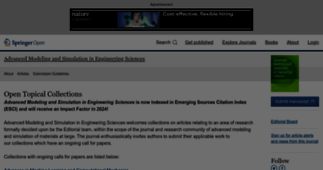Most Recent Articles: Advanced Modeling and Simulation in Engineering Sci...
Enter a key term, phrase, name or location to get a selection of only relevant news from all RSS channels.
Enter a domain's or RSS channel's URL to read their news in a convenient way and get a complete analytics on this RSS feed.
Unfortunately Most Recent Articles: Advanced Modeling and Simulation in Engineering Sci... has no news yet.
But you may check out related channels listed below.
[...] is applied to the target deformed configuration of the workpiece with the set of internal variables set to zero. Subsequently a direct mechanical formulation is performed on the resulting [...]
[...] problems. Given the limitted a priori error control in those cases, the sharp a posteriori error control is of even higher relevance. This paper derives (b) guaranteed a posteriori error [...]
[...] . Results: The capabilities of the proposed approach are illustrated by considering some numerical examples involving different degrees of complexity, from simple shells to composite laminates [...]
[...] , which is shown to be well-posed, and therefore automatically adjoint-consistent. Results: Numerical examples are presented to illustrate the computation and use of the adjoint solution in two- [...]
[...] formulation. This process is continued until convergence is reached. Results: In our three numerical examples in isotropic elastoplasticity, the convergence was reached after five, six and nine [...]
[...] Orthogonal Decomposition (POD) technique of model order reduction, for a parameterized quasi-nonlinear parabolic equation. Methods: A POD basis associated with a set of reference values of the [...]
[...] inverse form finding problems for isotropic elastoplastic materials, based on an inverse mechanical formulation written in the logarithmic strain space. First, the inverse mechanical formulation is [...]
[...] reduced model with the new coupling condition and to show its stability by numerical experiments. We then test the performance of the new formulation on benchmark examples and [...]
[...] in this interface problem and so narrows the efficiency reliability gap. Conclusions: Numerical experiments illustrate the theoretical convergence rates for uniform and adaptive mesh-refinements and [...]
[...] on GPUs will be covered, while special attention will be paid to techniques based upon model order reduction, a promising technique in the field. Finally, some review is made on techniques able to [...]
[...] : In what follows, we consider the Proper Orthogonal Decomposition (POD) technique of model order reduction, for a parameterized quasi-nonlinear parabolic equation. Methods: A POD basis associated [...]
[...] configuration of this component is sought. Methods: In this paper we present a new recursive formulation for solving inverse form finding problems for isotropic elastoplastic materials, based on [...]
[...] ” shell model without any phenomenological assumptions. Some analytical and numerical solutions are discussed that prove the relevance of the presented modeling. Conclusions: A [...]
[...] and theoretical estimates are considered in order to assess the behaviour of the numerical approximation. It is demonstrated that despite being regular, the convergence of the approximation can [...]
[...] is applied to the target deformed configuration of the workpiece with the set of internal variables set to zero. Subsequently a direct mechanical formulation is performed on the resulting [...]
Related channels
-
The Zero Life.Com
We Write About The Recent Science News, New Scientific Discoveries, Science Experiments Articles Current Events For Kids...
-
Mental Floss
Random, Interesting, Amazing Facts - Fun Quizzes and Trivia
-
IAES
Institute of Advanced Engineering and Science
- MacUpdate - Latest Updates
-
The Most Recent Articles Rss Feed - Articleonlinedirectory
The Most Recent Articles from Articleonlinedirectory - Free Online Articles - Publication and Submission

